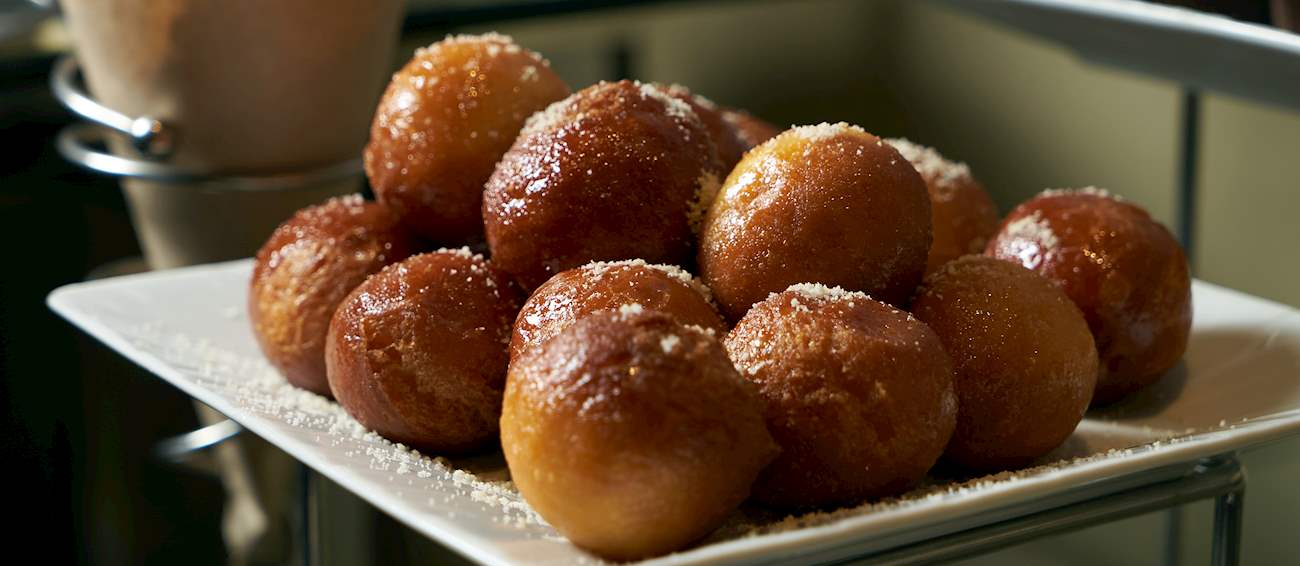MAIN INGREDIENTS
Translated as honey pie, this light Greek dessert is traditionally associated with the island of Sifnos, but its varieties can be found in other Greek regions as well. The pie combines fresh cheese, preferably mizithra based on sheep or goat milk, eggs, and honey, and it is usually baked as a round, crustless cake.
It is recommended to garnish melopita with a sprinkle of cinnamon and an additional drizzle of honey.
MAIN INGREDIENTS
Fouskakia are traditional Greek donuts or loukoumades that are prepared on the islands of Skopelos and Alonnisos, in the northwest Aegean Sea. The name of this specialty derives from the Greek word foúska, meaning a bubble, referring to the typically small spherical shape of the fluffy fried pieces of dough which resemble bubbles.
These donuts are typically made with a simple batter of flour, water, and yeast, and once deep-fried in oil, they’re usually eaten while still warm. Fouskakia are usually enjoyed drizzled with honey on top and sprinkled with cinnamon or nuts, although they can also be accompanied by scoops of ice cream on the side.
Though they are thought to have originated in ancient Phoenicia, melomakaronas are nowadays a typical Greek Christmas treat. These delicious semolina cookies are traditionally flavored with honey, orange zest, cinnamon and other spices, olive oil, and cognac.
Immediately after baking, melomakarona cookies are doused in honey syrup, then sprinkled with ground walnuts. Although some argue that another Greek treat that goes under the name finikia refers to a slightly different dessert, occasionally fried and served without walnuts, today both names are used interchangeably.
MAIN INGREDIENTS
Sfakianopita is a traditional Cretan treat that couples layers of thin, unleavened dough and soft white whey cheese. The pie is typically made with flour, olive oil, water, salt, and a shot of raki (Cretan tsikoudia), and rather than being filled with local myzithra cheese, the dough is kneaded with the cheese.
The whole combination is then flattened out into a thin, almost crepe-like or pancake-like circle and fried until golden, spotted, and crispy. Also known as sfakiani pita or mizithropita, this specialty is believed to have been created by Cretan shepherds from Sfakia, hence the name sfakianopita.
MAIN INGREDIENTS
This traditional Greek dessert consists of numerous phyllo sheets that are sprinkled with melted butter and coupled with a light semolina custard. When baked and well-chilled, the pastry is traditionally doused in the orange spiced, sugary syrup, allowing the layers to absorb the flavors and transform galaktoboureko into a soft, velvety treat.
This Greek classic is commonly found in pastry shops and traditional taverns across the country.
MAIN INGREDIENTS
A close relative of galaktoboureko—that is distinguished by the use of phyllo sheets—classic Greek galatopita combines semolina, milk, eggs, butter, and sugar into a creamy, custard-like treat. Often enriched with citrus zest (and wrapped in pastry in some regions), galatopita is baked until golden-brown and is typically garnished with a sprinkle of powdered sugar or cinnamon.
With its light texture and delicate flavor, it can be served on any occasion and is best enjoyed well-chilled.
MAIN INGREDIENTS
Hailing from Zakynthos, this traditional Greek dessert is prepared with fine semolina flour that is cooked in water until thick and creamy. The mixture is then poured into a deep tray, and when set, it is cut into large rectangular or diamond-shaped pieces that are deep-fried until golden and crispy.
Right before it is served, each piece is generously coated with cinnamon sugar. Fritoura is a staple dessert served at various festivities on Zakynthos, when it is usually prepared in large amounts and fried in traditional cauldrons.
MAIN INGREDIENTS
This traditional Greek dessert consists of layered or torn phyllo sheets that are blended with a creamy, orange-flavored yogurt custard. When baked, the cake is doused in a thick, sugary, orange-spiked syrup. Portokalopita is a classic that comes in different versions and often incorporates semolina, cinnamon, vanilla, and dried or candied fruit.
It is best served well chilled and is occasionally paired with ice cream.
Hailing from the Greek island of Crete, kalitsounia or skalotsounia is a traditional, small-sized snack that comes in numerous different shapes and can be both savory and sweet. In its most traditional form, it combines an unleavened pastry and a filling that consists of fresh cow's milk cheese called mizithra.
Sweet varieties enrich the cheese with cinnamon and lemon zest, while the savory versions occasionally employ spinach. Though it is traditionally associated with Easter, nowadays it is enjoyed all year-round.
MAIN INGREDIENTS
This simple no-bake treat consists of thick Greek yogurt that is doused in generous amounts of honey, then topped with walnuts. The yogurt is occasionally flavored with vanilla, while the best choice is to use traditional thyme honey and toasted walnuts.
Though simple in ingredients, yogurt with honey is a staple in many traditional taverns across the country and is typically enjoyed as a light breakfast or a refreshing dessert.
TasteAtlas food rankings are based on the ratings of the TasteAtlas audience, with a series of mechanisms that recognize real users and that ignore bot, nationalist or local patriotic ratings, and give additional value to the ratings of users that the system recognizes as knowledgeable. For the “Top 42 Greek Desserts” list until April 15, 2025, 3,381 ratings were recorded, of which 1,670 were recognized by the system as legitimate. TasteAtlas Rankings should not be seen as the final global conclusion about food. Their purpose is to promote excellent local foods, instill pride in traditional dishes, and arouse curiosity about dishes you haven’t tried.

































